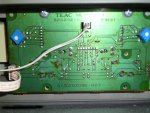ron-e-g
Member
Hello. been awhile since I've posted but...I've been around. Today I was checking the levels on the board. I engaged the on board oscillator set it to 1K And started sliding the PGM busses to set the VU meters at 0VU (nominal +4). All except buss 3 are close to the 0 mark on the fader scale. But buss 3 has to be raised to +7 VU above the others. I'm now wondering if it's the meter itself or the monitor module. As this board is all balanced (minus the direct outs). How is the best way to connect a tester to the PB-664 patchbay (TT/Bantam) to check the feed of the PGM-outs?
Also, the manual mentions adjusting the semi-fixed resistors on the VU PCB. How would this be done, if found to be necessary?
Ron
Also, the manual mentions adjusting the semi-fixed resistors on the VU PCB. How would this be done, if found to be necessary?
Ron


 I was only hoping to get advise from some others that have already traversed this road.
I was only hoping to get advise from some others that have already traversed this road.
 This board is indeed all ballanced except the Direct Outs. Too, all the connections are by way of D25 Subs. I think Tascam copied the idea from Neve and SSL. They all terminate into D-Sub (rear)/TT/
This board is indeed all ballanced except the Direct Outs. Too, all the connections are by way of D25 Subs. I think Tascam copied the idea from Neve and SSL. They all terminate into D-Sub (rear)/TT/
 no point in getting wound up about anything until you are measuring with the proper equipment.
no point in getting wound up about anything until you are measuring with the proper equipment.